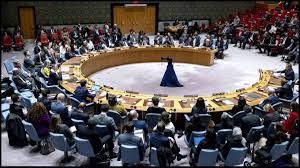
G4 Model-The need to reform the UNSC
G4 Model-The need to reform the UNSC
GS-2: International Organization
(UPSC/State PSC)
Important for Prelims:
G4 Model- Brazil, Germany, Japan and India, Permanent Representative of India to UNSC, Ambassador Ruchira Kamboj.
Important for Mains:
About G4 model, Need for reform in UNSC, Way forward, Conclusion.
13/03/2024
Why in news:
Recently, India presented a detailed model on behalf of the G4 countries for reform of the United Nations Security Council (UNSC).
About G4 Model:
This model has been presented by Ambassador Ruchira Kamboj, India's Permanent Representative to the United Nations, on behalf of Brazil, Germany, Japan and India.
Proposals related to this model have received strong support from a wide range of UN members.
New members: It is proposed to increase the membership of the Security Council from the current 15 to 25-26 by adding six permanent and four or five non-permanent members.
Regional representation: Six new permanent members are proposed, one each from African states and Asia Pacific states, one from Latin American and Caribbean states; and one from Western European and other states.
Flexibility on veto: The G4 model offered flexibility on veto, while new permanent members would, in principle, have the same responsibilities and obligations as current permanent members, they would not exercise the veto until a decision was made on the matter.
Permanent members not specified: The G4 model does not specify which member states will occupy the new permanent seats.
This decision will be taken by the General Assembly in a democratic and inclusive election.
About UNSC:
The United Nations Security Council (UNSC) is one of the principal organs of the United Nations, responsible for maintaining international peace and security.
It was established in 1945 as part of the United Nations Charter.
It is composed of 15 member states, including five permanent members with veto power—China, France, Russia, the United Kingdom, and the United States—and ten non-permanent members.
Its headquarters is in New York City.
Objectives of reforming UNSC:
Increasing the number of members: Increasing the membership of the Security Council from the current 15 to 25-26 by adding six permanent and four or five non-permanent members.
Six new permanent members are proposed, one each from African states and Asia Pacific states, one from Latin American and Caribbean states; and one from Western European and other states.
Making changes to the current structure: Major sectors are under-represented and un-represented in the current structure of the Security Council.
Ending the inability to address conflicts: The current structure of the Council is unable to address significant conflicts and maintain international peace and security.
Transforming the world order: The world has changed enormously since 1945 and new realities need to be reflected in permanent membership.
Any resolution that does not address the issue of representation of the global South, including Africa, Asia and Latin America, in the permanent category does a grave injustice to the aspirations of developing countries for equality.
Bringing flexibility to the veto power: Currently, only five permanent members have veto powers and its use has prevented action in the Council to address global challenges and conflicts such as Ukraine and Gaza.
The remaining 10 countries in the Council are elected as non-permanent members for a two-year term and do not have veto powers.
Legitimacy: The disproportionate power held by the five permanent members, particularly their veto power, can lead to perceptions of unfairness and lack of legitimacy.
Limitations in introducing reforms in UNSC:
Veto power of permanent members: Any reform in the structure or functioning of the UNSC requires the approval of the five permanent members.
These countries have different interests and are reluctant to support changes that might reduce their influence within the Council.
Regional dynamics: Regional rivalries and geopolitical tensions complicate efforts to reform the Council.
Complexity of the reform process: Amending the UN Charter to implement reforms requires a lengthy and complex process that involves ratification by a significant number of member states, which makes it difficult to implement concrete reforms.
Chinese opposition: China being a permanent member blocks the development of India becoming a permanent member.
Way forward:
It is important that both permanent and non-permanent membership represent the world today, not the world that existed after World War II.
Reforms of the UNSC are necessary to maintain its relevance, legitimacy and effectiveness in addressing the complex security challenges facing the international community in the 21st century. However, achieving consensus on such reforms among UN member states remains a challenging and ongoing process.
Conclusion:
The G4 model emphasizes that the Council's inability to address significant conflicts and maintain international peace and security underlines the urgent need for reform.
The current structure of the Security Council, with "markedly under-representation and non-representation" of key regions in both categories of membership, is "detrimental" to its legitimacy and effectiveness.
Source: The Hindu
------------------------------------------
Mains Question:
Write a short note on G4 model.
Mention India's efforts to reform the UNSC.